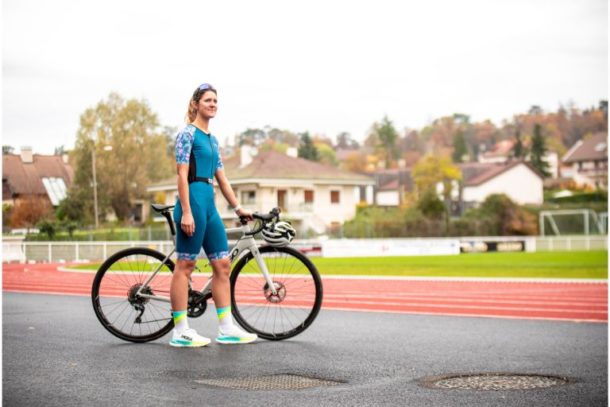
A structured triathlon training plan is important to prepare for this demanding sport that combines swimming, cycling, and running. To excel in triathlon or simply enjoy the sport, you’ll need to vary your training across the three disciplines. Let’s explore the key points of a Sprint (S), Olympic (M), or Half-Ironman (L) triathlon training plan, whether you’re a beginner or looking to level up.
Contents
Triathlon Training Plan: Swim Training
Swimming is the first segment of a triathlon. A good triathlon training plan should include swimming technique sessions, such as shoulder touch drills or kicking drills, to improve movement efficiency and breathing. New triathletes should master freestyle technique.
You can also include interval sessions, starting with a warm-up followed by 4×100 meters at high intensity. Swim sessions depend on your level and target distance (you’ll do longer intervals for L or XL formats).
Finally, you can also do endurance swimming sessions. This helps you learn to swim relaxed and build volume in a low-impact sport, reducing the risk of running injuries.
Triathlon Training Plan: Cycling Training
Cycling requires endurance and power. This is true regardless of the triathlon course profile. Riding fast on flat terrain is a skill that must be learned and trained.
Triathlon training plans may also include hilly rides to build leg strength and improve pacing uphill (especially if you’re doing Embrunman, Mont-Blanc Triathlon, Triathlon de la Madeleine, etc.). In all cases, cycling interval sessions are great to make progress.
Indoor trainer sessions can help control cadence and intensity. It’s important to focus on proper hydration and nutrition during long rides.
Triathlon Training Plan: Run Training
Running is the final segment, and it can be the toughest after swimming and cycling. A triathlon training plan must include easy aerobic runs for recovery and interval sessions to build endurance and speed.
Interval sessions should be adapted to your race distance (5km, 10km, 21km, or 42km), with race-specific pace work.
Running drills can also be beneficial, especially for athletes coming from cycling or swimming backgrounds.
Combining Disciplines & Transitions
Combined sessions, or “brick workouts,” are useful to get used to transitioning between disciplines on race day.
They involve switching quickly from swimming to cycling or cycling to running, helping you adapt to muscle changes and save time in transitions.
Recovery & Nutrition
In triathlon preparation, recovery is just as important as active training. Rest days allow your body to regenerate and adapt to training load.
Nutrition plays a key role, especially carbohydrate and protein intake after workouts to support muscle recovery. Sleep is also essential!
Your Triathlon Training Plan on RunMotion Coach
A good triathlon training plan should be balanced and progressive, taking technique, endurance, strength, and recovery into account. It must be adapted to the athlete’s level and race distance.
By following these principles, triathletes can optimize performance and fully enjoy the triathlon experience.
The RunMotion Coach app was originally a running app—a core part of our expertise. We later added cycling and swimming to deliver a complete triathlon training plan.
How Many Training Days Per Week?
In the RunMotion Coach app, you can choose your triathlon training days for running (2 to 7 sessions), plus two cycling and swimming sessions.
This means you can do up to 7 running sessions, 2 cycling sessions, 2 swim sessions, and 2 strength training sessions if you’re highly motivated, strong, and have the time!
At minimum, you can do 2–3 runs (usually easier to fit into your schedule), 1 cycling session, and 1 swim session. For many triathletes, that’s already a great base. You can of course add sessions depending on your schedule, your current training load, and your goals.
We wish you the best in your triathlon preparation! You can download the RunMotion Coach app to get your personalized triathlon training plan!